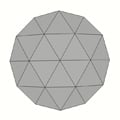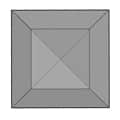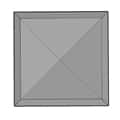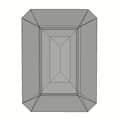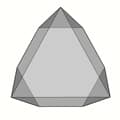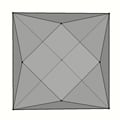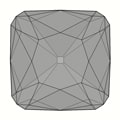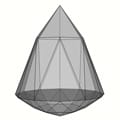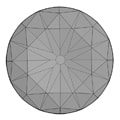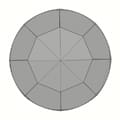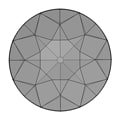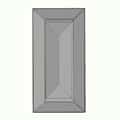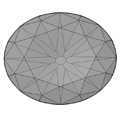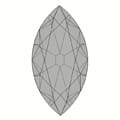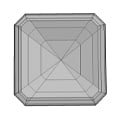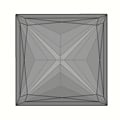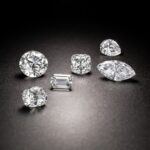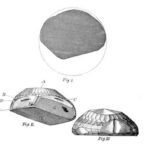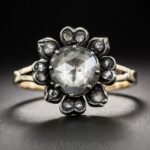Diamond Cuts & Shapes
Pre-Roman Diamonds

You shall make a breastpiece of judgment, in skilled work. In the style of the ephod you shall make it—of gold, blue and purple and scarlet yarns, and fine twined linen shall you make it. It shall be square and doubled, a span its length and a span its breadth. You shall set in it four rows of stones. A row of sardius, topaz, and carbuncle shall be the first row and the second row an emerald, a sapphire, and a diamond. Exodus 28:15 – 28:18
This reference has caused people to believe that diamonds were known in biblical times. But the ‘diamond’ comes from the erroneous translation of the Hebrew yahalom and Greek adamas.
The early history of the diamond is shrouded in mystery. When the first diamonds started playing a role in the lives of humans is simply unknown. Looking at the available literature the same thing keeps popping up: accurately translating ancient texts is very difficult. Two words which often have been translated into diamond, the Hebrew יהלום (yahalom – derived from halam which means to beat) and the Greek αδάμας (adamas which means indomitable or invincible) have caused confusion.
When we read the old testament we encounter several diamonds 1 but their existence is solely based on the translation of the Hebrew yahalom. The word was used to indicate an extremely hard mineral, that is certain, but assuming that it was actually referring to diamond is a modern thought. We know that diamond is the hardest substance on earth but was it known as the hardest in biblical times too?
Greek literature indicates the same issue. The use of the word adamas, for instance by Plato, has been seen as an indication of diamonds being known to the Greeks but in fact, there is zero proof that this was the case. The word adamas was probably used to describe gold, Metals (Non-Noble) and perhaps even corundum.
Early gemological historians didn’t have access to (translated) Sanskrit texts so one hardly ever reads anything on India’s own historical sources on the use of diamonds. When diamonds became a part of our lives is unclear but where they entered is completely certain: in India.
An old Indian work, named the Arthasastra, which can be dated back to the 4th century BC gives us the first proper insight in when diamonds were first used. By then diamonds were known, traded and even taxed in India. The existence of diamond experts is mentioned together with a classification of diamond. This implies a rather thorough knowledge of the subject, something which could lead to the belief that diamonds were in use for quite some time by then.
Roman Diamonds
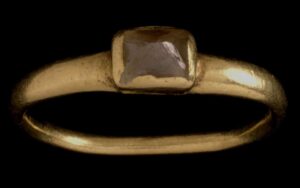
© The Trustees of the British Museum.
Diamonds were known to and worn by the Romans. They were highly prized as ring stones and a few rings containing uncut diamonds have survived and are now in the collection of The British Museum. Pliny writes about diamonds in his Naturalis Historia, calling them: ‘The substance that possesses the greatest value, not only among the precious stones but of all human possessions’. He doesn’t mention any fashioning of the stones at all. What he does note is the incredible hardness of diamonds and (probably without knowing) Pliny mentions its perfect cleavage:
These stones are tested upon the anvil, and will resist the blow to such an extent, as to make the iron rebound and the very anvil split asunder. Indeed its hardness is beyond all expression … When, by good fortune, this stone does happen to be broken, it divides into fragments so minute as to be almost imperceptible. These particles are held in great request by engravers, who enclose them in iron, and are enabled thereby, with the greatest facility, to cut the very hardest substances known.1
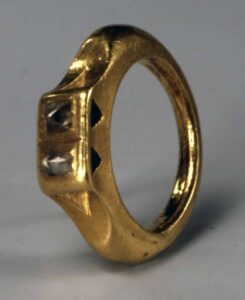
© Trustees of the British Museum.
Some of the quote above certainly sounds like diamonds are being discussed but Pliny mentions a few things which don’t add up. This must indicate that he confused some other minerals with diamonds. Herbert Tillander, who has written an excellent book on the history of diamond cutting, expresses his doubts about the Romans having access to perfect crystals; the Indian suppliers would certainly have kept the better stones for the native market.
Diamonds were believed to protect the owner from all kinds of mishap and, for a long time, it was believed that this divine crystal would lose its powers when it was in any other state than the natural one. Cutting diamonds was as much a taboo as it was difficult in the Ancient times. Tillander suggests that diamond cutting started with removing mineral matter off the faces of freshly mined crystals, which makes perfect sense. Whether controlled cleaving was being performed is unknown. This is such a rudimentary practice that there were no technical limitations preventing the ancient people to apply it to their off-shaped diamond rough but historical or archaeological proof of any early cleaving lacks completely.
The Introduction of Diamond Cutting
After the decline of the Roman empire diamonds disappeared from European jewelry altogether. India was the only source of diamonds until the 18th century and the supply chain to Western Europe got disturbed by the lack of Roman merchants. The spread of Christianity had already subdued the popularity of the gem. The new religion condemned the superstitious attributes which had accompanied the stones. Contrary to the European situation, the gem retained its popularity in the Indian and Islamic world and it is in historic sources from these regions where interesting historical references are to be found.
The Ratnapariska by Bhudda Bhatta, an Indian text which, at least, dates back to the 6th century notes the following:
Wise men should not use a diamond with visible flaws as a gem; it can be used only for polishing of gems, and it is of little value.
Since polishing other gemstones with a full crystal isn’t feasible this text must have indicated the grounding up of bad quality diamonds in order to create diamond powder.
 Our historical trip then takes us to the 10th century where Al-Biruni writes this:
Our historical trip then takes us to the 10th century where Al-Biruni writes this:
…these people also say that it (the diamond) is the hardest amongst all precious stones and overcomes all other stones, yet the softest and least compact metal breaks it, that is, the lead which is wax like. …It (the lead) also pulverizes the diamond… When on grinding and pulverization its (the diamond’s) pieces get smaller the jewelers coat them with something that keeps the flies away.
Now, why is this so interesting? First, here we have reliable historical sources telling us that 6th-century Indian lapidary workers and 10th-century Islamic jewelers were grinding up diamonds in order to polish other stones. What is remarkable is that somewhere else in the same text Al-Biruni dismisses a stone from being a diamond because it’s crystal faces could be polished. This would imply that the polishing of diamonds with diamond dust wasn’t known yet by the 10th century.
Jack Ogden, a notable jewelry historian, reports to have seen Medieval Islamic jewelry that could be dated back to the 13th century which contains simple Table Cut diamonds.2 These would be the oldest known cut diamonds in existence. Ogden’s report coincides with historical literature. An Indian text named the Agastimata, which unfortunately hasn’t been accurately dated but is believed to be written shortly after the 13th century AD, teaches us the following:
The diamond cannot be cut by means of metals and gems of other species; but it also resists polishing, the diamond can only be polished by means of other diamonds.
Europe

European diamond cutting would have originated in Venice, shortly after 1330.3 This is indeed very likely since it was only after Venetian merchants started opening up the trade routes to the East that diamonds started trickling into Europe again. Whether cutting techniques were part of this new import to Europe isn’t clear but can be called plausible given the fact that both the practice of grinding poor quality diamonds to dust and the cleaving of diamonds were known by the men who were supplying the Venetians with diamonds: the Islamic merchants. Definite proof of where diamond cutting originated hasn’t been found yet, it could just as easily have been a European invention which backtracked the road the diamonds traveled.
Just as in Ancient times, perfectly shaped crystals would not have been reaching the West in any quantities. Their popularity in India would have caused the better samples to be preserved for the local market and the Islamic middle-men would certainly have picked the eyes out of the supply as well. Perhaps this is why Europeans started to cut diamonds? It is possible that the demand for perfect crystals and lack of such a supply triggered the start of diamond fashioning in Europe.
Technical limitations caused the first cutters to stick to what their rough allowed them to do. At first diamond cutting would have been nothing more than superficial polishing of the existing rough. The introduction of continuous rotary motion in craft tools in the 15th century enabled cutters to grind facets into diamonds with greater ease which expanded the possibilities. This triggered more creativity and a wider variety of cuts.
Transition
Following the Venetian re-opening of the East, the Dutch, Portuguese, Spanish and English naval explorations to all corners of the globe assured a new, and steady, influx of luxury goods into Europe. The Portuguese conquered the City of Goa in 1510, which they made the main diamond port of India. This enabled Europe’s diamond supply to grow considerably. Compared to the past, better rough would have been made available now that a direct line of supply was set up. It should be noted though that diamonds weren’t plentiful at all. Their status would have only risen from super rare to rare.

When, towards the end of the 15th century, the European economic center of gravity shifted from the Mediterranean to the North sea, Paris, Bruges, and Antwerp rose as the main polishing centers in Europe. The cutting communities there were very small ones and they were excluded from the Guild system, making it possible for Jews to participate in the trade and fashioning of the hardest stone on earth. The Northern European states had seen an influx of Jewish people from Portugal, Spain and later France due to the Christian extremist environment in those countries which eventually resulted in the Inquisition. It was within these new communities that the diamond trade and cutting techniques developed.
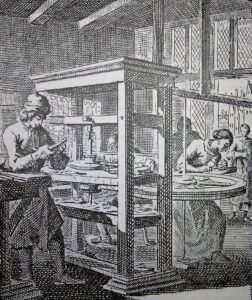
A diamond cutting mill is depicted here from a copper plate engraving made in 1720 based on a 16th-century description. The image shows that diamonds weren’t always ‘a girl’s best friend.’ By the end of the 15th-century diamond cutting changed. The crystal shape was no longer holy and cutting techniques improved which resulted in more creative cuts. Godehard Lenzen, a notable German gemologist, writes of a court document of the city of Augsburg in which a diamond is mentioned that weighed 11.50ct before polishing and only 5ct after. This weight loss illustrates the progress in shaping diamonds. Diamond cutting in the full sense of the word had made its entry.
The developments in the 16th century lead to a shift from a mere polishing of natural crystals to genuine ‘faceting’. The Rose Cut emerged and the early table cuts received extra facets on both the crown and pavilion to form an array of new cuts. Longer rectangular stones, named Hogbacks by Tillander formed a forerunner to the Baguette Cut and were extensively used to form letters and figures. Diamonds were cut to shape to be combined into Rosettes. The most popular cuts were the Table Cut and Point Cut. Examples are found in the images that have been left to us from 16th-century manuscripts such as Kleinodienbuch der Herzogin Anna von Bayern.
The cutting techniques of the 16th century have been extremely well documented by Benvenuto Cellini in The Treatises of Benvenuto Cellini on Goldsmithing and Sculpture from 1568 which reads:
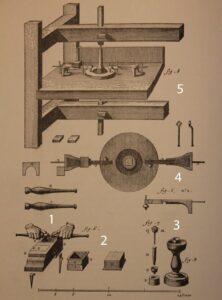
1. Bruting
2. Container/Sieve to Collect Diamond Powder Produced by the Bruting.
3. Dopping.
4. Wheel & Quill
5. Polishing Rig.
Now for just a word about the cutting of the diamond, that is to say on the changing of the stone from its roughness into those lovely shapes so familiar to us, the Table, The Faceted & the Point. Diamonds you can never cut alone, you must always do two at a time on account of their exceeding hardness, no other stone can cut them; it is a case of diamond cutting diamond. This you do by means of rubbing one against the other until a form is obtained such as your skillful cutter may wish to produce (image 1), and with the diamond powder that falls from them in the process, the final polish is subsequently given (image 2). For this purpose, the stones are set in little cups of pewter (image 3) and held against a wheel by means of little pinchers prepared on purpose (image 4), and they are thus held with their dust mixed with oil. The steel wheel upon which the diamonds are cut and finished should be about the thickness of a finger & the size of an open hand and of the finest steel excellently tempered. This wheel is fastened to a hand mill and turned around as fast as it is possible to turn it. Four to five diamonds, or even six, can be applied to the wheel at the same time (image 5), and by bringing to bear a sufficiently heavy weight you can increase the pressure of the diamonds upon the wheel and give greater grip to the dust which wears them away, and so they are finished.
This extremely accurate and detailed account is of great value for us investigators of the history of diamond cutting. It teaches us that the technique of bruting, be it in a very primitive form, was known and applied by 16th-century cutters. In summary, by the16th-century the bruting, faceting and polishing had been mastered by European cutters.
Grinding
There are a few physical properties of diamond you should know about to properly understand diamond cutting. The first is in addition to what you probably already know: the diamond is the hardest substance on earth and can only be cut by diamond itself. The addition to this knowledge is that a diamond has ‘directional hardness’. It is harder in certain directions than it is in others. The sides of an octahedral crystal, for instance, are harder than dodecahedral planes. Note that hardness, when it is used in a gemological context, stands for the ability to withstand scratching, not its ability to withstand blows. The easiness with which a stone breaks falls under the gemological heading of ‘toughness’.The ease with which a facet can be introduced into a rough diamond depends on the orientation of that facet in regard to the crystallographic planes. Diamond dust consists of millions of particles which, when they are applied on a cutting wheel, are spread out with random crystallographic orientations. Some will be hitting the stone on which the cutter is working with their softest direction and have no impact whatsoever, some with the hardest and will slowly cause the facet to be formed. The relative ease with which a facet can be introduced depends on its orientation to the crystallographic planes of relative hardness. In some directions, more particles will be effective than others. This causes some restrictions to cutters. The octahedral crystal faces, for instance, lie in planes of great relative hardness and are therefore virtually impossible to be polished. Very few particles in the diamond dust would be effective. Cutters, therefore, have to introduce facets on planes which differ a few degrees from the harder crystallographic planes.
Cleaving
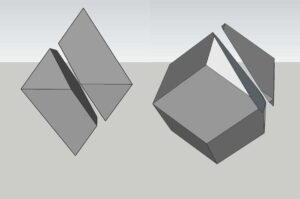
The second property of diamond which greatly influences diamond cutting is that of cleavage. Of all minerals diamond scores the highest on the hardness scale but it doesn’t score as high on the toughness scale. Diamond has perfect cleavage which means that its crystal structure allows extremely smooth fractures to occur when force is applied in the appropriate directions.The introduction of cleaving diamonds in order to shape them prior to faceting and polishing is believed to have its origins in the 16th century. Breaking up diamonds into sharp fragments to be used for engraving had been known since antiquity and an Islamic publication by Ahmad ibn Yasuf al Tifaschi from the mid 13th century mentions the perfect cleavage in diamonds but the use of cleaving in gem cutting appears to be a post-medieval invention. De Boodt mentions it in his 1600 AD publication Gemmarum et Lapidum Historia. That this technique was probably known earlier in India can be deduced from J.B. Tavernier who wrote in 1665:
…when the miners see a stone in which there is a flaw of some size, they immediately cleave it, that is to say split it, at which they are much more accomplished than we are.
The apexes which can be knocked off dodecahedral crystals presented the diamond cutters with flat, naturally faceted slivers of rough. These thin bits of diamond formed the earliest Rose Cuts which, over time and after some evolution, became extremely fashionable until well into the 20th century. Another example of fashioning by cleaving is the Shield Cut, which is basically half an octahedron. In addition to the above, it is worth mentioning that facets need to be placed in planes which differ a few degrees from cleavage planes in order to take a good polish. When a facet lies parallel to a cleavage plane it will not take a satisfactory polish due to microscopic flaking of the surface.
Sawing
Finally, a new craft was added to the repertory of cutting techniques: that of diamond sawing. This addition to cutting techniques completed all the stages in diamond cutting as we know it today: cleaving, sawing, grinding and polishing. The method, described by de Laet in his 1647 lapidary De gemmis et lapidibus: libri duo consisted of dressing a thin wire with diamond powder mixed with oil and running the wire across the stone. This extremely labor intensive method was used until well into the 19th century but of course, cleaving was preferred given its relatively easy use.
Indian Diamond Cutting
We can’t speak about diamond cutting without getting into J.B. Tavernier’s travel accounts which have been bundled into his Six Voyages of Jean Baptiste Tavernier in which he provides a great insight into Indian diamond fashioning of the 17th century through his illustrations and text:
…the mill was like ours, the large wheel of which was turned by four blacks. The Indians do not agree with us in believing that weighting them causes flaws in the stones. If theirs do not receive any it is because they always have a small boy who holds in his hand a very thin wooden spoon, with which he anoints the wheel incessantly with oil and diamond powder. Added to which their wheel does not go so fast as ours, because the wooden wheel which causes the steel one to revolve is seldom more than 3 feet in diameter.The Indians are unable to give the stones such a lively polish as we give them in Europe; this, I believe, is due to the fact that their wheels do not run so smoothly as ours. For, being made of steel, in order to grind it on the emery, of which it has need every twenty-four hours, it has to be taken off the tree, and it cannot be replaced so as to run as evenly as it should do. If they possessed the iron wheel like ours, for which not emery but the file is required, it is not necessary to remove it from the tree in order to file it, and they could give the stones a better polish than they do. I have stated that it is necessary to rub the wheel with emery or to file it every twenty-four hours, and it is desirable that this should be done every twelve hours if the workman is not lazy. For when the stone has run a certain time, the part of the wheel where it has pressed becomes polished like a mirror, and if the place be not roughened by emery or the file, the powder does not stick to it. When it does adhere more work can be done in one hour than in two when there is none on the wheel. Although a particular diamond may be by nature hard, having, so to speak, a kind of knot, one such as is seen in wood, the Indian diamond-cutters would not hesitate to cut such a stone, although our diamond-cutters in Europe would experience great difficulty in doing so, and as a general rule would be unwilling to undertake it ; but the Indians are paid something extra for their trouble.
The product of the Indian style of cutting has been named the Mughal Cut. The term Mughal Cut is better understood to be describing ‘a diamond cut in India in the 16th, 17th or 18th century’ rather than a certain shape or arrangements of facets.
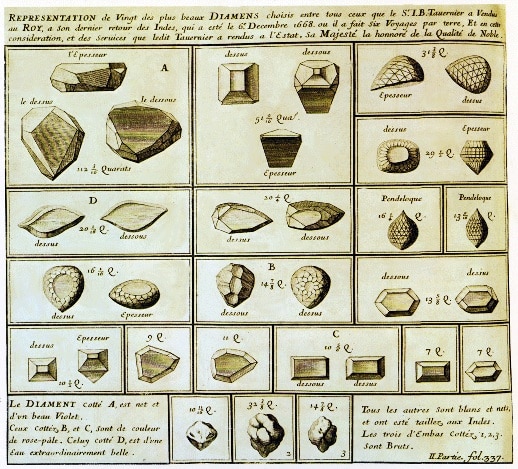
Baroque Roses and Brilliants
Roses
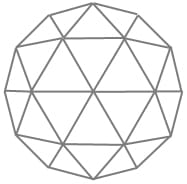
As said before the Rose cut was developed into a more standardized version during the late 16th century. The Belgian and Dutch cutters specializing in this cut were turning thinner bits of rough into the ‘new’ standard Rose; a flat-bottomed gem with a crown covered in diamond-shaped facets. These new Roses increased in popularity over the second half of the seventeenth century and increased in thickness when its popularity allowed bulkier rough to be used for this cut. Their dome shape became higher and higher as their popularity grew.
The Birth of the Brilliant
A new perception of what a diamond should look like slowly emerged over the 17th century. The candle-lit dinner parties of the Baroque era demanded a more sparkling design, something that could complement the Rose Cut stones: brilliants.

Image Courtesy of Christie’s Images, 2008
Thinking that these brilliants resembled the modern round brilliant is a mistake though. The first brilliants were anything but symmetrical and had all sorts of outlines, depending on the rough they were fashioned from. Dodecahedral rough would yield stones with a roundish outline, octahedral rough square ones. The terms square and round should be taken with a grain of salt here, ’round’ was rarely truly round and ‘square’ almost always involved the shape we nowadays refer to as ‘cushion’, a squarish outline with rounded corners. What they do have in common with the brilliant cut as we know it is that it was a pavilion based cut (meaning that the bulk of the weight is in the lower part of the stone) with triangular and diamond-shaped facets on both its crown and pavilion.
Other cuts like the Marquise formed variations of the Brilliant design applicable to rough which favored other shapes than round or square. Famous examples of early brilliants are the Wittelsbach and the Grand Sancy. It should be noted, however, that these new gemstone cuts were still vastly outnumbered by the table and point cuts, sided by rose cuts of all shapes and sizes until well into the 18th century when Indian diamonds became more scarce and the old cuts started to be recut en masse.
Enter Brazil
Just when the Indian diamonds mines started to become exhausted the first diamonds started to be found in Brazil in an area which subsequently got named after it’s crystalline riches: Diamantina. Here the first crystals were discovered in alluvial deposits around 1725 and by 1730 a steady production became a reality. Individual and independent miners were working the new deposits and their constant prospecting for new deposits caused new diamond localities to be found all over Brazil during the entire eighteenth century, boosting the world’s availability of diamond rough like never before. The new deposits yielded that many stones that the prices of diamond rough dropped to only 30% of what they had been prior to the Brazilian discovery! This price drop and increased availability caused diamonds to become less exclusive. Where they had been more or less reserved for European nobility up until halfway through the 18th century they now became available to a much larger public. The cutting industry grew, profiting from this larger demand. The Brilliant gradually took over the old cuts. The 18th and 19th centuries were the time of the Old Mine Cut stones.

Eureka
The rise of a prosperous middle class in Europe and the United States over the 19th century caused an enormous increase in popularity of diamond jewelry. Due to that increase in demand diamond prices rose again when the Brazilian supply decreased towards the mid-nineteenth century. The European cutting centers in London, Antwerp, and Amsterdam which had seen a huge growth of their cutting houses over the first half of the 19th-century experienced problems when the Brazilian mines started to produce less and less in the 1860’s.Not surprisingly the discovery of the Eureka diamond in South Africa around New Year 1866-1867 wasn’t just a ‘Eureka-moment’ for the 15-year-old boy who found the stone but it also marked the rescue of the Dutch and Belgian diamond cutting industries.
Modernization
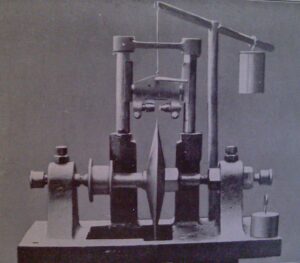
A major event in the history of diamond cutting was the invention of the bruting machine by Henry D. Morse and Charles M. Field in the early 1870’s. They established British and U.S. patents for steam-driven bruting machines in 1874 and 1876 respectively. The first electric bruting machine was invented in 1891. These inventions meant the birth of the commercial application of the first truly round brilliants.
The motorized diamond saw was invented by a Belgian immigrant in the USA in the year 1900. It enabled cutters to accurately shape their rough in directions which prevented cleaving from being performed. The new technology and enormous influx of rough from South Africa caused the glory days of the cutting houses to start. Plenty of customers, a steady supply of rough and mechanized cutting machines changed the ancient craft of diamond cutting into a modern industry. The round brilliant slowly morphed into the ‘ideal cut’ and became the standard cut for diamonds. New cuts like the Asscher Cut (realized in 1902) catered for those who wanted something out of the ordinary. The Baguette Cut was (re)introduced in 1912. One of the more modern cuts is the Princess Cut which was developed in the sixties.
The diamond cutting centers of Antwerp and Amsterdam were comprised of predominently Jewish owned and operated businesses. The Holocoust decimated the Jewish population during World War II and the diamond cutting industry in these two cities never fully recovered. In the years following the war, diamond cutting centers were erected elsewhere with Israel becoming a major player, and later, India also became a noted diamond cutting nation.
More recently, new techniques such as virtual 3D modeling to determine the best yield from rough as well as highly accurate laser sawing have been developed in order to maximize profits.
Related Reading
Sources
- Naturalis Historia, Pliny, 1st century AD.
- The Book Most Comprehensive in Knowledge on Precious Stones by Al-Biruni. Originally Written in the 10th Century,
- The Treatises of Benvenuto Cellini on Goldsmithing and Sculpture by Benvenuto Cellini, translated by C.R. Ashbee. Originally Written in the 16th Century, Translated in 1898.
- Produktions und Handelsgeschichte des Diamantes by Lenzen, Godehard, Duncker & Humblot, 1966. English Translation. ISBN 9780214650840
- Diamond Cuts in Historic Jewellery 1381-1910, Tillander, Herbert. Art Books International, 1995.
- The Nature of Diamonds, various authors, edited by G.E. Harlow, Cambridge University Press, 1998.
- Gem-A Mailtalk Forum, 2011.
- Directional Hardness in Diamond on Minsocam.org

